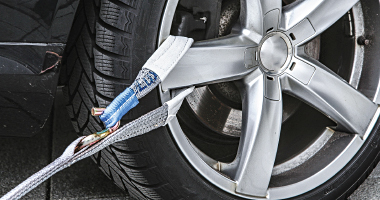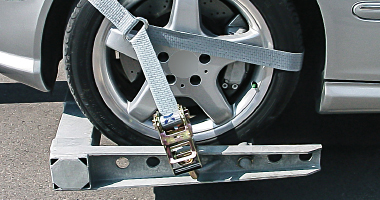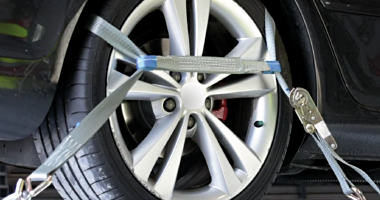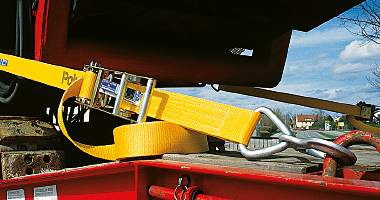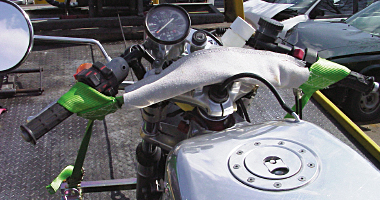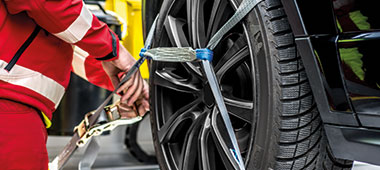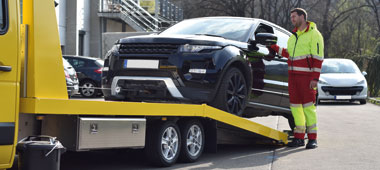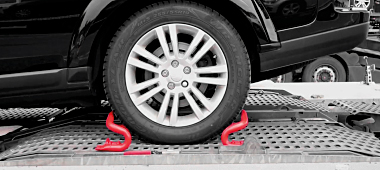Tie-down straps

Tie-down straps
Safety straps for every purpose
ProLux tie-down straps are available as one-piece lashing straps or as two-piece lashing straps. The one-piece lashing strap consists of a ratchet or a buckle and the strap and is often used for strapping material. The two-part lashing strap consists of the ratchet with short strap and hook, as well as the longer loose end with hook. Two-part lashing straps are universally applicable and are the most widely used type of tie-down strap. Thanks to the different lengths, widths and tensile forces of the lashing straps with different hooks for fastening, almost all applications can be covered. Using lashing rail systems, vans can also be retrofitted with lashing rail systems so that efficient load securing is also possible here, providing optimum transport securing for motorbikes, cars and lorries. Special requirements are to be met by the vehicle safety straps used for vehicle transport. There are explicitly defined regulations for this in the Association of Engineers (VDI) 2701 Sheet 8.
Overview of different safety tie-downs
These are two-part wheel tie-down straps that have been specially developed for securing loads during vehicle transportation. The well-designed ...construction and the convenient length of the safety straps enable optimum handling when applying the tie-down straps. You can secure the vehicle wheel over the tire or rim with the range of different versions of the retaining straps. There are also suitable wheel tie-down straps for sensitive alloy rims or for securing perforated sheet metal on vehicle transporters.
Read moreStronger vertical movements of the forklift vehicle mover can cause the vehicle to be thrown out of the frame during ...the journey. Safety straps for forklift vehicle movers hold the vehicles securely in the frame during transport. The tensioning straps enclose the wheel. The tensioned safety tie-down strap holds the vehicle wheel firmly in the forklift frame due to the resulting contact pressure. Different versions of our safety tie-down straps for forklift vehicle movers are available for every situation.
Read moreThere are also suitable safety tie-down straps for cars or vans up to 3.5 tonnes that are transported on towing flatbeds or ...on trailers - i.e. tie-down straps specifically for smooth transport floors without openings. These are secured via existing tie-down points. The tie-down strap holds the wheel over the tyre or rim. Thanks to the many versions available, you are guaranteed to find the right ratchet lashing strap for every application.
Read more HGV tie-down straps are heavy-duty and durable tie-down straps with a width of 75 mm. They allow you to ...safely transport heavy loads such as trucks or construction machinery on your low-loader. These tie-down straps are characterised by particularly strong and durable straps with very sturdy fittings.
Read moreThere are also tie-down straps specially developed for the transport of motorbikes. These lashing straps secure ...the motorbike over the handlebars or the frame, for example. This prevents damage to the motorbike fairing caused by the tie-down straps.
Read moreIn public road transport, it is a legal requirement to secure loads properly. Our lashing rails offer ...an effective solution for correct load securing. In combination with our lashing straps and matching accessories, they ensure that your load is secured safely and correctly.
Read moreApply wheel tie-down straps & tension belts correctly
Tie-down straps secure loads of all kinds during transport. The lashing straps, also known as tension belts, ensure that your load cannot slip during transport. Load securing is mandatory by law. The ratchet of the tie-down strap is used to create tension in the strap. Lashing straps tensioned in this way secure your load safely during the journey. All ProLux tensioning belts comply with DIN EN 12195-2. Sturdy, galvanised ratchets and impregnated polyester webbing guarantee a high level of quality.
Please find below a practical guide to the correct and safe use of your tie-down straps.
1
Check straps for damage
Always check the fittings and the belt itself for damage before using the tie-down straps. Tie-down straps with deformed ratchets or fittings and webbing with cuts or severely chafed webbing must no longer be used. Also, missing or illegible safety labels oblige you to discard the tension belts.
2
Secure the load correctly
Your load must be secured against horizontal and vertical movement using the tie-down straps. This can normally only be achieved by using several tie-down straps. Your load securing equipment must be able to hold the weight of the load. In the event of full braking, the tie-down straps can take up to 80 % of the load weight. You will find the maximum load capacity (Fzul) of the straps on the safety labels of the tie-down straps.
3
Attach straps
When attaching, make sure that the hooks rest neatly on the base of the hook. Never load the tip of the hook. The tie-down strap must not be twisted or passed over sharp edges.
4
Tie down the load
The strap is guided through the slot in the ratchet bolt and slightly pre-tensioned by hand. Now tension the strap by moving the ratchet handle up and down. At least two belt windings must be applied to the slotted bolt so that the ratchet can maintain the pre-tension. After tensioning the strap, press the ratchet handle downwards and allow it to engage. This secures the ratchet against unintentional opening.
5
Check tension regularly
Check the tension of the load securing belts several times during the journey. If necessary, make sure to re-tension.
6
Release the load
The straps are released by folding the ratchet handle 180 degrees. To do so, pull the safety lever on the ratchet handle and then push the handle backwards. Note that if the belt tension is high, the ratchet may kick back slightly when opening.
Explanation of the strap label
1. Annual UVV inspection
Field for marking the annual UVV inspection: Here you can mark yourself when the next UVV inspection of the belt must be carried out. By law, this should be carried out every 12 months by an expert.
3. Length of the strap
Length of the entire strap measured in metres.
5. Manufacturer/supplier
The name or logo of the manufacturer or supplier must appear on the label.
2. Tracing code
The traceability code enables exact tracing back to the manufacturer and the batch with the help of the date of manufacture and the name of the manufacturer.
4. Date of manufacture
Code for traceability: Together with the date of manufacture, the batch can be traced back to the manufacturer. This allows the manufacturer to recognise when and by whom the batch was tested. They can also see which components were used.
6. Safety note
Safety instructions to be observed for the respective belt type. Load lifting equipment must not be used for load securing and load securing equipment must not be used for lifting loads.
-
-
Field for marking the annual UVV inspection: Here you can mark yourself when the next UVV inspection of the belt must be carried out. By law, this should be carried out every 12 months by an expert.
-
The traceability code enables exact tracing back to the manufacturer and the batch with the help of the date of manufacture and the name of the manufacturer.
-
Length of the entire strap measured in metres.< /p>
-
Code for traceability: Together with the date of manufacture, the batch can be traced back to the manufacturer. This allows the manufacturer to recognise when and by whom the batch was tested. They can also see which components were used.
-
The name or logo of the manufacturer or supplier must appear on the label.
-
Safety instructions to be observed for the respective belt type. Load lifting equipment must not be used for load securing and load securing equipment must not be used for lifting loads.
-
7. Material of the webbing
The first 3 letters indicate the material of the webbing. The material also determines the colour of the label. The most common material for webbing is polyester. The label colour for polyester is blue.
9. Lashing force
The lashing capacity - abbreviated to LC - indicates the tensile force the strap can withstand at the weakest point. The force is given in daN (decaNewton). 1 daN corresponds to approx. 1 kg and force/weight.
11. Standard tension force
The standard tension force (STF) is the force generated by the SHF (#10) during lashing. The STF pushes the load onto the loading surface with this pre-tensioning force and thus increases the coefficient of friction of the load. The STF is influenced by many factors, such as the length of the handle or the ratio of the ratchet.
8. Norm
The standard specifies the standards that the belt must fulfil during use. You can find out more about the respective standards here.
10. Standard hand force
The standard hand force (SHF) is the force that an average user can apply by hand to the tensioning ratchet.
12. Elongation of the strap
The elongation of the webbing material in per cent describes the maximum elongation that the webbing stretches during lashing. Legally permitted values are a maximum of 7% or a maximum of 4% - depending on the belt type.
-
-
The first 3 letters indicate the material of the webbing. The material also determines the colour of the label. The most common material for webbing is polyester. The label colour for polyester is blue.
-
The standard specifies the standards that the belt must fulfil during use. You can find out more about the respective standards here.
-
The lashing capacity - abbreviated to LC - indicates the tensile force the strap can withstand at the weakest point. The force is given in daN (decaNewton). 1 daN corresponds to approx. 1 kg and force/weight.
-
The standard hand force (SHF) is the force that an average user can apply by hand to the tensioning ratchet.
-
The standard tension force (STF) is the force generated by the SHF (#10) during lashing. The STF pushes the load onto the loading surface with this pre-tensioning force and thus increases the coefficient of friction of the load. The STF is influenced by many factors, such as the length of the handle or the ratio of the ratchet.
-
The elongation of the webbing material in per cent describes the maximum elongation that the webbing stretches during lashing. Legally permitted values are a maximum of 7% or a maximum of 4% - depending on the belt type.
-


